Forsythia is an easygoing shrub for USDA Hardiness Zones 5 to 8 that is best known for its bright yellow springtime flowers.
And while we consider it to be a low-maintenance plant, left to its own devices, it may become a tangled mess of bare woody stems.
In our guide to growing forsythia, we discuss everything you need to know about cultivation.
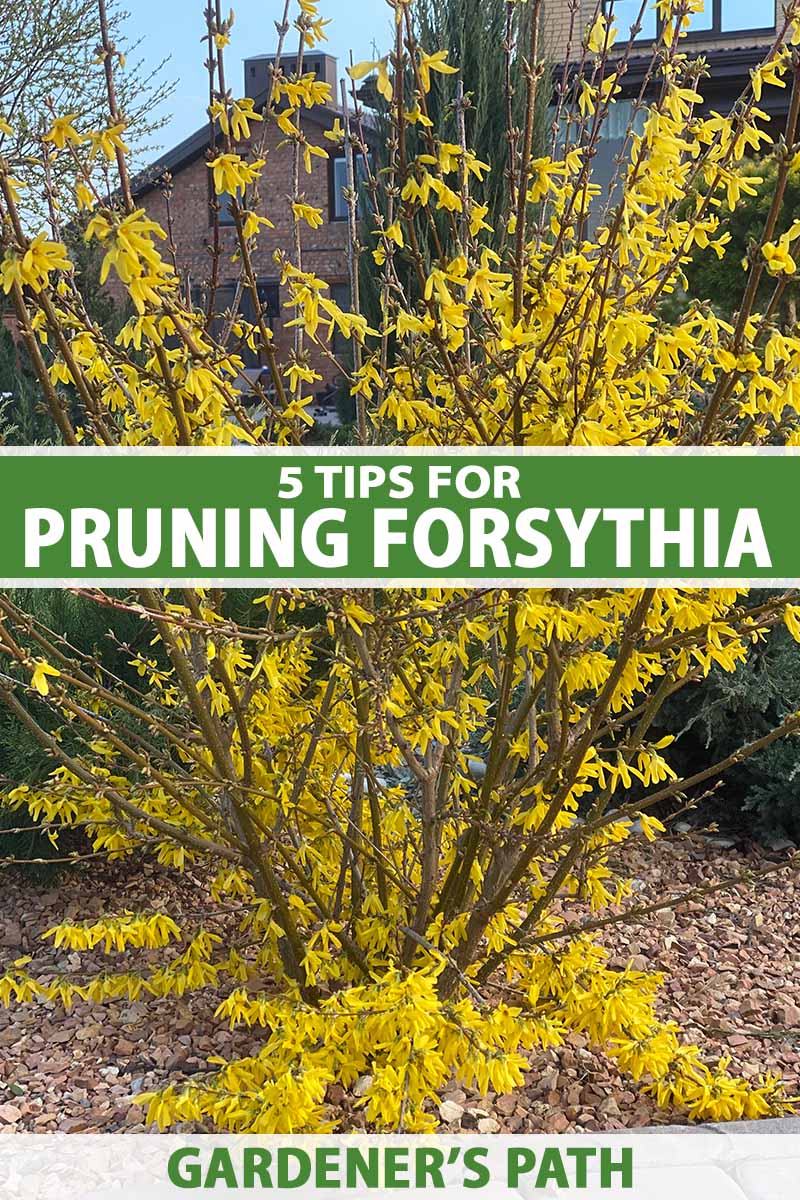
We link to vendors to help you find relevant products. If you buy from one of our links, we may earn a commission.
This article offers 5 tips for pruning forsythia to maintain its vigor and attractiveness.
Here’s what’s in store:
5 Tips for Pruning Forsythia
We may trim forsythia for a variety of reasons, including:
- Creating a pleasing shape
- Promoting more blooming
- Reducing size
- Rejuvenation of older plants
- Removing dead or damaged foliage
- Thinning out dense, twiggy growth
To trim forsythia branches, you’ll need hand tools for a variety of branch sizes, such as a bypass pruner, lopper, pruning saw, power pruning saw, and long-handled bypass pruner.
They should be clean and sharp to make smooth cuts, inhibit the spread of disease in the garden, and reduce the risk of personal injury.
The best time to prune shrubs is when the weather is expected to be dry for a few days.
Wet weather can have an adverse effect on cut branches, as the damp, open “wounds” create a prime breeding ground for disease, especially that which is fungal in nature.
Ready to get started? Here are five tips for success!
1. Timing Is Critical
Forsythia is one of the earliest bloomers, with flowers that open in late winter to early spring.
The blossoms appear, and they are followed so quickly by foliage that there are often yellow blooms and green leaves on the stems at the same time.

By early summer, a flush of new growth sends canes shooting up two feet or more. Within them, the buds for next year’s flowers begin to form.
To ensure an abundance of blooms next spring, prune right after the flowers finish blooming. At this time, it’s easy to see the “bones,” or branches that give the shrub its shape.
In addition to pruning immediately post-bloom for optimal flowering next season, there are three occasions that may warrant cutting at other times.
The first is the removal of debris. If your plants have dead branches that bear no flowers or foliage, damaged branches, or areas that are infested with pests or disease, you’ll need to remove them to maintain the health of the shrub.
The second is the cultivation of formal forsythia hedges. In this case, each time there is a flush of growth, you cut it back by one-half.
The purpose here is more about maintaining size and shape than promoting flowering.
And the third is a complete overhaul, when you are faced with a shrub that is huge and out of control, or dying, and you want to try to start it over from scratch.
This final option can be done at any time from winter dormancy through the summer growing season, as the immediate priority is manageable, healthy growth, not flowers. They’ll come later.
2. Make Cuts Where the Stems Originate
Generally, when we trim a shrub, we cut the stems back to an outward facing leaf node. This encourages new growth that projects away from the center, to promote good air circulation.
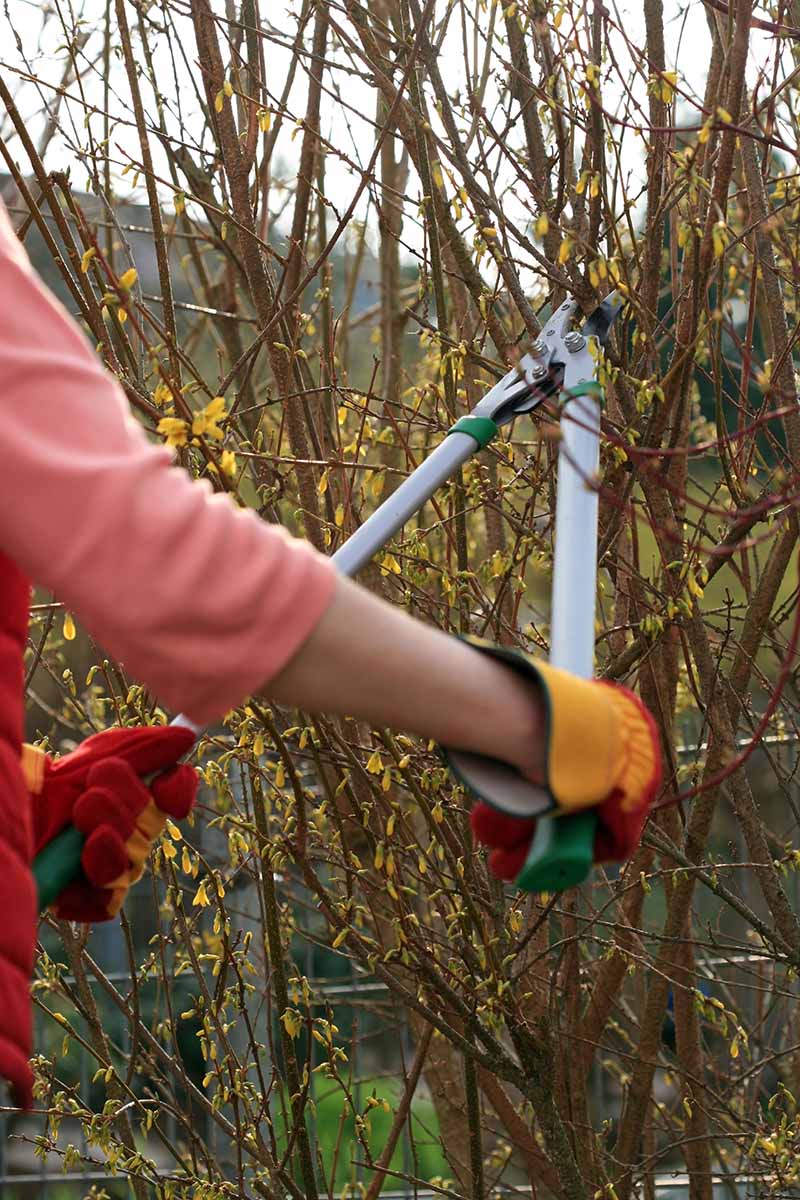
However, while cutting branches mid-stem can help to maintain a desired shape, with forsythia, it may result in fewer flowers.
Here’s why.
Forsythia grows on “old wood.” Now, this doesn’t mean the widest diameter, oldest, hardest stems we see at the bottom of the shrub. As you may have noticed, these tough branches don’t flower.
No, old wood means last year’s growth. Think about it for a minute.
We prune right after flowering in early spring, and then a flush of new stems, or canes, grow in early summer.
They shoot straight up two feet or more, depending upon the variety, and set buds all along their lengths for next year’s flowers.
When you cut mid-stem, two short stems grow from that point. These lateral stems don’t generally produce as many blossoms as a “main” cane does.
Contrary to popular belief, the healthiest, most flower-laden bushes are not the densest, most branching, but rather the airiest, least branching, with the longest straight main canes.
What does it all mean?
When you make a cut into a bush, it should be at the point where a stem originates. This can be where it joins an older woody branch, at the base of the shrub itself, or as low as you can possibly go toward the base.
Cutting in this way generates long, bloom-laden canes.
3. Thin Routinely
By its second or third year, a forsythia shrub may need some thinning out.
The airier the better, so if you see a lot of dense, twiggy growth in the middle, so thick that you can’t see through it to the other side, it’s time for thinning.
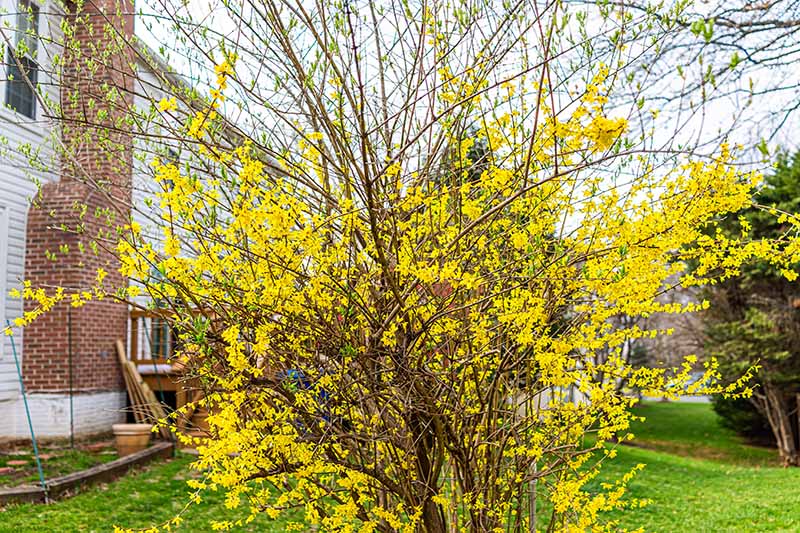
Resist the urge to jump into the middle and start cutting an airhole.
Instead, remove up to one-third of the largest diameter stems – from the bottom.
If it’s hard to see the multi-branched bottom of the shrub, begin by pruning off all branches that touch the ground, at their points of origin.
They are only going to “tip-root,” and grow lots of little plants all around the main one, reducing airflow, and increasing vulnerability to pests and disease.
Once they are removed, you should be able to see the main stems. If they are thickly clustered, you may not be able to cut them to the ground. That’s okay. Cut them off as low as you can go.
Pay special attention to branches that cross one another, as the rubbing creates a wound that is vulnerable to water penetration, pests, and disease.
When you find crossed stems, you may have to remove several, if they are damaged. Retain those that are not rubbing, and project outward from the center.
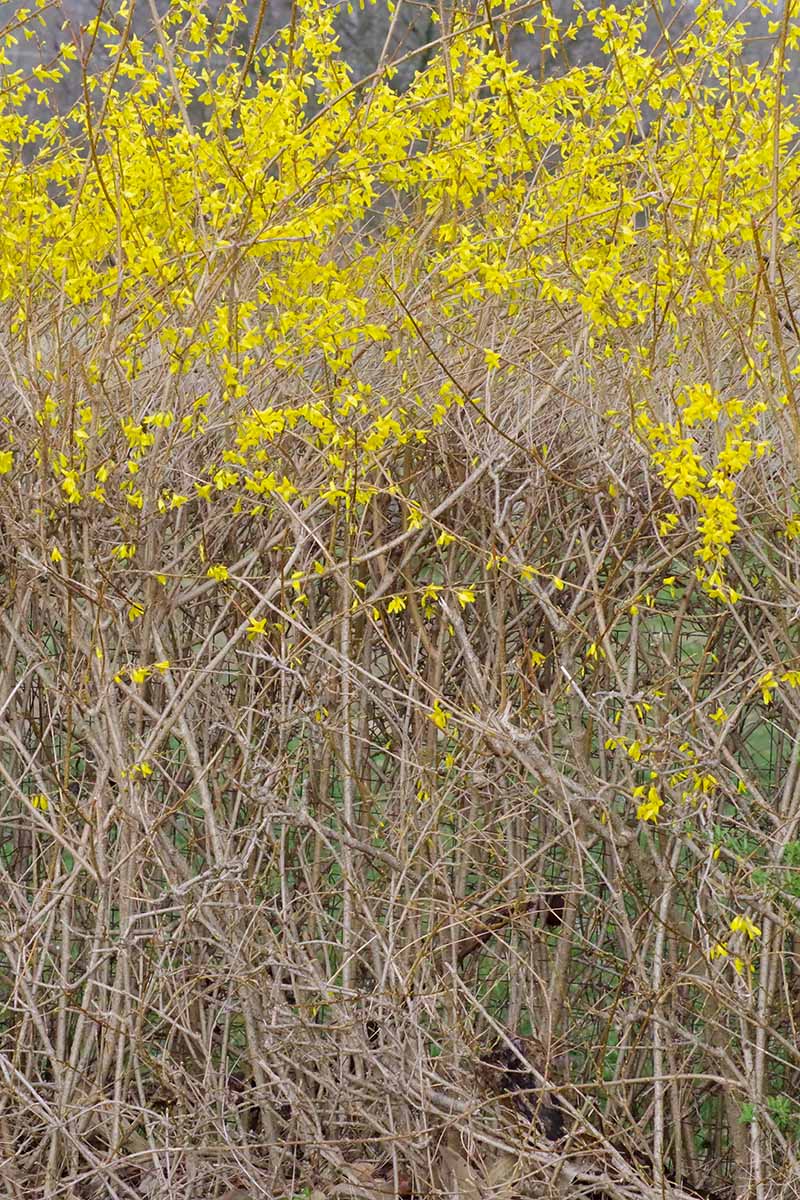
And finally, branches that are way out of alignment with the rest of the shrub can be cut to their points of origin to maintain pleasing proportions.
Some of the branches you cut off may be as tall as the shrub itself, and their removal is going to look scary, as it leaves gaping holes.
No worries. This is what we want. You should be able to put your arm through these openings; they should be that big.
By next season, fresh new canes will have shot up in their places, bearing abundant blooms.
If you do this every spring, every three years you will have a completely renovated, vigorous, productive shrub with a balanced, natural shape.
Remember to do this with hedges, too, or you’ll end up with a lot of old wood that doesn’t grow leaves or flowers.
4. Rejuvenation
Sometimes a shrub seems to be beyond repair. It may have been neglected for years by the time you inherited it with your new home, and has become a woody tangle with few blossoms.
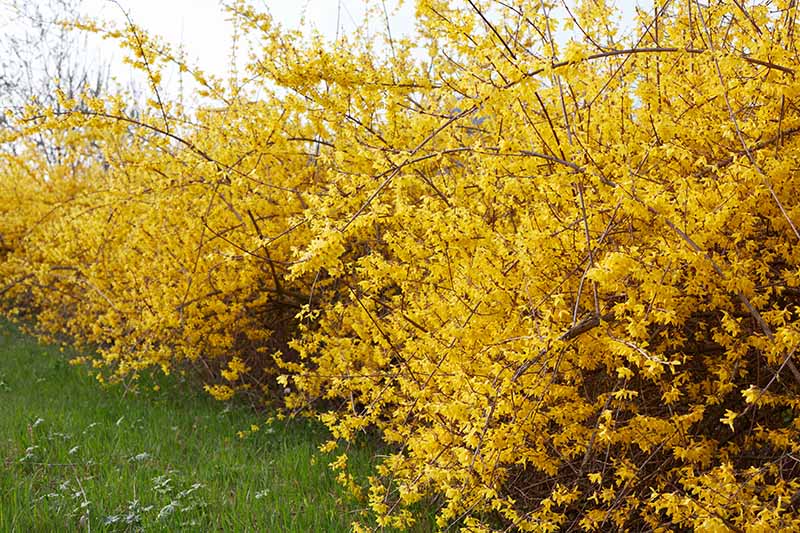
Instead of trying to pick out which branches to salvage, you might go all in and do a deep pruning to attempt to rejuvenate it from the ground up.
Before you do so, you may want to take some stem cuttings to root, just in case it can’t take the shock and dies.
(Basically, forsythia grows so easily that if you cut a few stems and put them in water, or directly into the ground, they are almost sure to grow roots and can be transplanted back into the garden.)
Choose the hand or power tool most appropriate to the diameter of the woody stems, and cut them as low as you can go. Over the next two years, the plant will either make an outstanding comeback, or it won’t.
Total rejuvenation is a desirable choice when a large shrub has been planted in a small space, to the detriment of those around it.
It is an extreme option for old plants that you’re considering for removal.
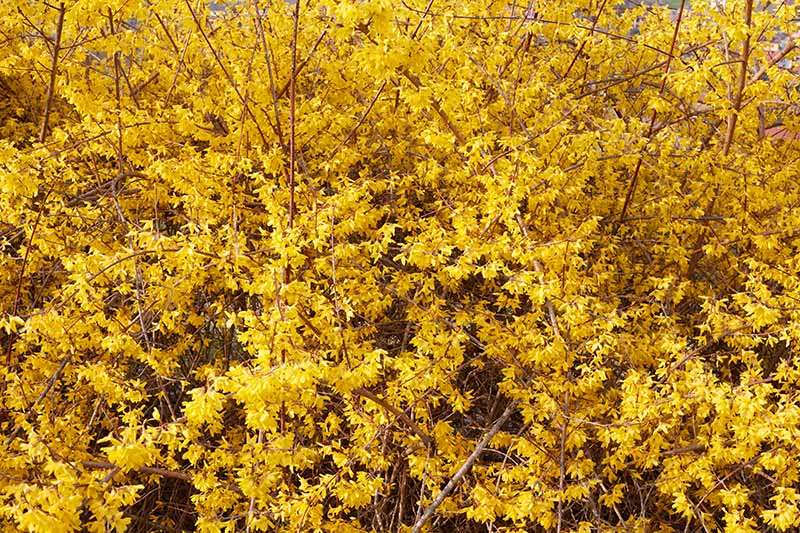
If your plant takes the deep pruning well, healthy new growth will appear, giving you the opportunity to start over.
Keep in mind that a forsythia is not a tree with a single trunk, but a shrub with multiple stems that form a well-balanced base.
You can let the new canes shoot up, and wait two or three years before beginning a pruning regimen.
Some folks like to start pruning with the first flush of growth, cutting it by half to encourage lateral branching.
This creates an especially strong base, an asset when growing hedges, or in wind-prone locales.
We have a guide that explores rejuvenation more deeply.
5. Cut One Stem at a Time
Unless you are cutting a bush to the ground to start over, or you’re pruning a formal hedge, you don’t want to “gang” cut forsythia stems.

This is because cutting off the twiggy tips of the stems results in lots of weak, branching growth with few flowers, instead of the sturdy vertical main stems that bear the most blooms.
In addition, the weak growth is dense and inhibits airflow. It’s also more likely to suffer frost damage, breakage, and the ill effects of pests and disease.
Instead, cut each stem individually to its point of origin, working around the shrub in a balanced fashion.
Do a little bit each year, and soon the new vertical growth will become dominant, and your bushes will be airier and have more flowers.
Doing It Right
Having shared these five tips for success, now I can admit the truth.
I didn’t do right by my forsythia. They grew so easily from cuttings popped right into the ground, that before I knew it, my yard was bordered with them.
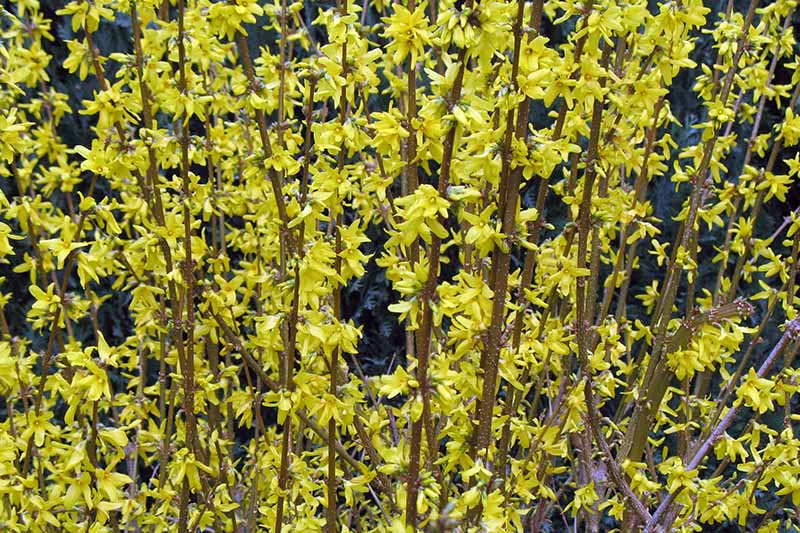
What I didn’t know was that the original cuttings that were gifted to me were from a 10-foot variety, and that I would spend the next seven years lopping the tops off the heads of their progeny to maintain a neighborly hedge, when I should have been digging them out and buying a compact variety with which to replace them.
This is why forsythia is both loved and hated by many. The folks who drive by in the spring “ooh” and “ahh,” while the unsuspecting gardener curses their rapid growth and ever-expanding forms.
I cannot stress enough that with the right size shrub in the right location, and a refreshing yearly pruning, you can literally forget them for the rest of the year, and they are wonderful.
Take it from me. Whether you do your forsythia right from the start, or battle behemoths like you are the boss, there’s just something about those yellow blossoms that makes it all seem so worthwhile.
If you found this guide informative and would like to read more about caring for forsythia, we offer the following guides:
- 7 Reasons Why Forsythia May Not Bloom
- 5 Common Causes of Forsythia Yellowing
- 11 of the Best Forsythia Varieties for Glorious Spring Color
- How to Manage Forsythia Gall Disease
© Ask the Experts, LLC. ALL RIGHTS RESERVED. See our TOS for more details. Uncredited photos: Shutterstock.
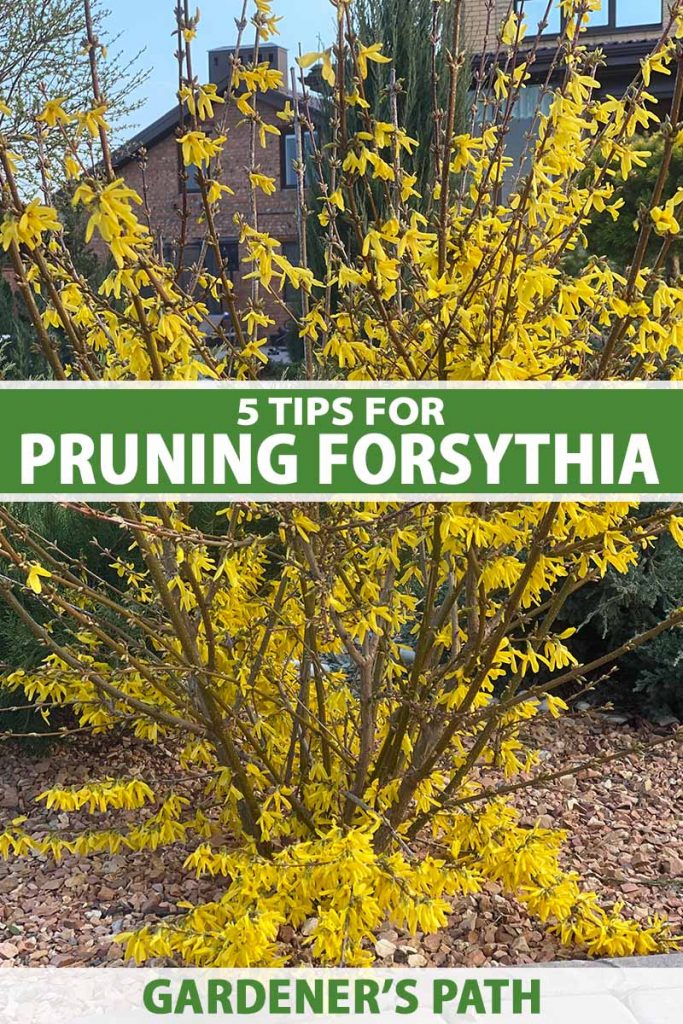

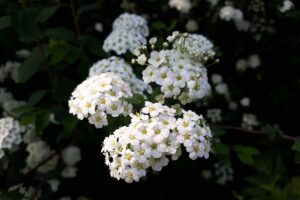
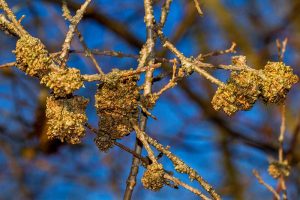
Happy to have found this article. Since we’re new to East Tennessee, and never had Forsythia before discovering it in our backyard this spring. Thanks!
Hello Douglas –
Welcome to Gardener’s Path. We wish you well in your new home.
Hi Nan,
What is the best time of year to prune forsythia all the way down to the root? Have a bunch of unwieldy ones in the front of our new home. I pruned them per direction of this article last year, but now they look a bit floppy and messy and are leaning into the road. Think they need a fresh start but we love them and their location. Chainsaw or clip each shoot individually as low as they can go?
Hello Blake – It’s best to prune forsythia just after blooming, in order to avoid cutting off next year’s developing buds. However, you can deep prune for rejuvenation purposes at any time from winter dormancy right through the summer season, if the need to prune outweighs the desire for flowers. As for the technique, it’s best to cut individual branches with clean pruning shears. Make sure they are sharp, to avoid creating ragged edges that inhibit “wound” healing and invite pests and disease. And finally, cut as low as you can go without damaging the crown, meaning you should still… Read more »
Hi Nan-I lived in my home for 30 years. Starting last year my flower beds started getting what looks like onion grass. I don’t know why this is happening! I live in North Jersey and we have a lot of deer, could this be a reason? Thank you. Helen
Hi Helen – You may have Melica bulbosa, one of several types of wild onion (and garlic) commonly called onion grass. It grows exceptionally well in organically-rich loam, but also thrives in soils of lesser quality. Deer don’t usually favor onion grass, although consumption and seed dispersal are a possibility. It is more likely that onion grass seeds were present in a package of grass seed used near the flower beds, in a wildflower mix, or in another type of seeds planted directly in the beds. And finally, there may be onion grass growing nearby that wasn’t mowed, causing seeds… Read more »